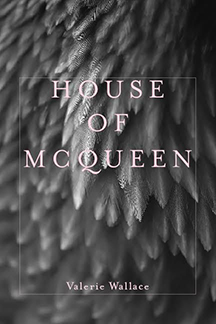House of McQueen Review by
Charles Rammelkamp
House of McQueen
Poetry
Four Way Books, 2018
$15.95, 66 pages
ISBN: 978-1945588112Selected by Vievee Francis as the winner of the Four Way Books Intro Prize, Valerie Wallace’s House of McQueen is a stunning evocation of the life and work and mind of the fashion designer, Alexander McQueen, who rose from a humble childhood in public housing to an address in the affluent London neighborhood of Mayfair by dint of his work ethic and genius as a couturier. McQueen committed suicide in 2010 at the age of 39.
Wallace’s collection roughly traces McQueen’s talent from his incipient interest in design to his full-blown success, but without really presenting a biographical sketch. Initial poems like “Council House, 1972,” “Fabrication,” “Shears” and “Needles,” present the budding talent, cleverly naming the tools of his trade, presenting McQueen's interior struggle to realize his artistic drive. “I’m still waiting / For my soul to catch up with me,” Wallace writes (McQueen reflects) in “Fabrication,” and “I think with my bare hands” in “Needles.” “It’s only cloth, whisper scissors in my ears.” (“Shears”)
Other biographical touchstones include “Savile Row, 1985,” referring to McQueen’s apprenticeship with different tailors (Anderson & Sheppard, Gieves & Hawkes) where he honed his skills and earned a reputation as an expert in tailoring; “Central St. Martin’s College of Art and Design, 1991,” in which Yvonne Humble recognizes his talent, on the basis of his portfolio, and gets him into the MA fashion course, despite his lack of an impressive curriculum vitae or financial resources. “Bespoke” is a series of seven sonnets made out of the recorded words (in print, video and tweet) of seven different influential patrons, artists, designers, including models Naomi Campbell and Kate Moss, the Icelandic singer Bjork, and the fashion stylist Isabella Blow, who was said to have persuaded McQueen to go by his middle name Alexander, rather than his first name Lee. As with most of the poems in House of McQueen, the poems are first-person, in McQueen’s voice. Made Out of Kate Moss’ words reads:
When I started out, fashion aspired to trends.
Designers still traffic together.
Obviously. Now I’ve got lots of friends
Still I show both sides: beautiful and vulgar.
I don’t see myself as what people buy.
Sleeve, skirt, legs, hips, wedding, glamour: perfect
Fit. I never rest til the details get right.
Know what I mean? Exposed defeat.
Nasty is gorgeous when you work it.
Find your art in each element. Nothing is precious
In my house. Nightmares paired with red tartan.
Frocks undone by marvelous vices.
Perform my clothes like you’re devastated.
I’m not finished ‘til you’re implicated.McQueen’s edgy aesthetic and eventual reputation for the risqué are on display here. In her generous notes that follow the poems, Wallace identifies McQueen quotations and fashion shows that inspire certain poems. “I like a good Grimm tale,” for instance, is an observation McQueen is said to have made. “I was the highwayman riding hard through inky nights,” the poem begins. McQueen had a reputation as “the hooligan of English fashion,” “l’enfant terrible,” based in part on his lavish and unconventional runway shows; on his “bumsters,” the lowrise jeans he made famous in his 1996 “Taxi Driver” show (McQueen’s father drove a taxi.). Wallace’s poem, “Bumsters,” begins “I cut / a path to / the sacred / tired of / suggestions….”
Many of Wallace’s poems on the page are themselves “fashioned,” as if taking off from their subject, including “McQueen Tartan,” “I’m a Free Bitch,” “Haute Couture (acrostic)” – based on a quote from McQueen, “…at the end of the day, they’re only clothes” – “McQueen Neoprene,” “McQueen Linen,” “McQueen Cashmere,” and the gorgeous “In this one there are dancers,” which is like a sunburst on the page, each line a ray, or a flower, each line a blossom, a wheel, each line a spoke. The poem, Wallace tells us in her notes, is after McQueen’s 2005 spring/summer show, Deliverance.
Wallace easily traffics in the vocabulary of fashion, which makes House of McQueen a delight. In “Winged” she writes:
From the tiny bloom
of sternum I sweptover shoulders, fanned,
arc’d. Slit for heavy arms.You can see the man at his worktable. More grandiose, in “Silhouette for the 21st Century,” she writes, “I announce a new world / In which your madness and my madness / At the point of a needle, is my love, spinning.” And in “Autobiography of Alexander McQueen”:
Fashion should predict the time we’re in, not reflect it.
Life is a transformation!We not only see the man at work, we are introduced to his aesthetic, his worldview. The collection ends touchingly with two poems, “Joyce & Lee” and “Lee,” based on a 2004 interview in The Guardian in which McQueen was interviewed by his mother, Joyce, who was a social science teacher. “What makes your heart miss a beat? Love.” The question/response that ends “Joyce & Lee” anticipates the first of the three-part final poem, “Lee”:
I feel
deep
anarchy
the calm
part
getting into it
captures
dying before
your heart
misses
a
beatValerie Wallace’s poetry is as dazzling and elegant as a gown displayed by a runway model.
